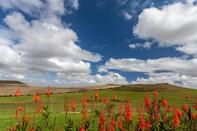Since ancient times, aloes have been recorded in Egyptian hieroglyphs and in the San and Khoi rock paintings and has a long history of medicinal uses in traditional cultures.

Africa has over 360 species of the genus Aloe linneus of which the Aloe ferox is the most used and commercially produced in South Africa. Aloe ferox is different from aloe vera (Aloe barbadensis).
In ‘ferox’, the bitter aloin is found just under the skin and can easily be separated from the gel-like inner leaf. In ‘vera’ the aloin is found throughout the leaf and is extracted in a chemical process.
The Aloe ferox has been found to have a 28% higher level of aloin and 36% more amino acids than Aloe vera, which is indigenous to America.
Aloe Ferox and Aloe Vera Benefits
Two components of the plant are used. The juicy gel has reputed wound-healing properties while the latex (bitter yellow layer containing the aloin) is said to have laxative properties but can help against arthritis.
The gel encourages skin healing after sunburn or radiation, relieves itching and insect stings and is widely used in cosmetics for its moisturising and soothing effects.
The gel also contains antioxidants, vitamins (A, C and B12) as well as bradykinase, an enzyme that reduces inflammation when applied to the skin. It is also used as a natural skin lightener as it contains melanin-inhibiting compounds.
An oil is produced by adding the macerated aloe leaves in a base oil such as grapeseed or sweet almond oil. The powder is used in medicines and the fresh leaf can be applied directly to the skin to relieve sunburn.
Growing Aloe Ferox
Aloe ferox grows well from seed, but propagating from cuttings is more popular. Saplings are transplanted after two years and leaves are harvested after five years, the plant grows wild in a broad range of habitats, from the south Western Cape to the KwaZulu-Natal Midlands.
The Aloe ferox near the Southern Cape town of Albertinia are harvested from both cultivated and wild-growing plants. About 50ha of Aloe vera is planted on farms in the Limpopo province while Aloe ferox is mainly harvested wild by farmers in the Southern and Eastern Cape.
Medical disclaimer
Information is for educational and informational purposes only and may not be construed as medical advice. The information is not intended to replace medical advice or treatment offered by healthcare professionals.By Marinda LouwFor bulk or Aloe Ferox export enquiries please use the enquiry link below.